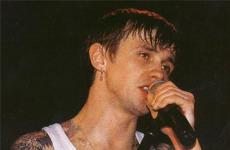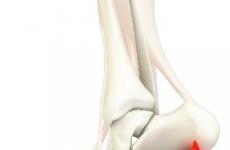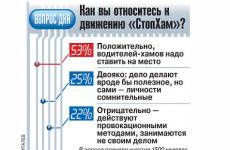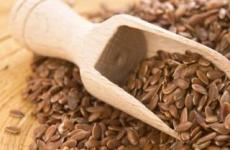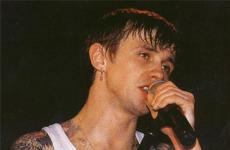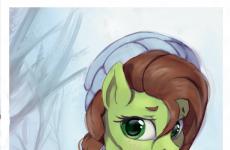An example of a description using the method of verbal portrait. Rules for describing a person using the verbal portrait method
a) A sample of a self-portrait using the example of material from the Internet:
He is shy and modest - as far as the acting profession allows. He is sober about his achievements. A serious artist with a subtle lyrical and comedic talent Andrei Kaikov comments on the most important thing.
Who am I?
“I am a person who likes life. And I like my different roles - actor, father, friend, son ... In each of them I manage to feel in my place and be in harmony with the situation. Accept what is. I like to communicate with other people and do not oppose myself to them. But at the same time, I am a rather secretive person and am not ready to discuss my personal problems with anyone. It’s difficult even for my family to get something out of me. I took this quality from my father: he does not like to invade the lives of others, to interfere with someone, to impose. And this is also characteristic of me. I am hardworking, quick-tempered and responsible, but I don't think it came with age. It seems to me that I am not changing. Rather, I grow in breadth, like a tree: new branches appear, but the trunk, the core remain one. "
b) Words used to describe a person's character:
You can describe a person's character in the words: optimist, generous, open, practical, wise, sociable, hospitable, sociable, responsible, calm, caring, man of his word, inattentive, firm, reliable, logical, low-emotional, attentive, insightful, influential, sensitive, polite , witty, talkative, funny, proud, impulsive, tactful, arrogant, cocky, friendly, etc.
v) Take your own self-portrait.
Samples of work:
- There is one boy living in my city. HM. No.
One boy lives in my house.
One boy lives in my room - me.
He (I) is a very interesting person.
Graceful, cultured, slightly annoying, a little nuts.
He was born in the distant past. Well, right 14 years ago.
He graduated from an institution called "nothing."
He is currently studying at the Mkhitar Sebastian educational complex.
Earlier, he was educated at the school named after "Hakob Kojoyan".
I heard rumors that a few months ago he started writing poetry.
He writes badly, but I like his style.
They say that his poems are very cruel, directed towards someone dear to him.
They say he is in love, suffers from unrequited love.
For some reason, I do not believe in these rumors.
He is too lazy, when he enters the threshold, I myself saw him sit down in a chair and starts playing his stupid games !!!
In the morning, I find it difficult to persuade him to wake up. He is often late for school. And not only to school, I can tell you.
I followed him, and it turns out that he always and everywhere comes late.
Here is such a person of my contemporary.
But despite all his defects, despite everything bad about him, I love him very much.
He's just darling. - Voskanyan Eric
C) work in pairs / groups: in a few minutes, based on several questions to each other, make a verbal portrait of your peer from Georgia / Armenia and present him. And the one whose portrait was made says how accurately it was made and what was the mistake. When drawing up a portrait, pay attention to
- Appearance
- Actions.
- The next part of the lesson is conducted using the "Perspective" technology.
Four creative teams are being created. Each of the groups works in a specific role position: innovators, optimists, pessimists, experts.
- Innovators present their personal self-education program;
- Optimists highlight everything positive, positive in the presented program;
- Pessimists pay attention to everything negative, ill-considered in the self-education program;
- Experts summarize and analyze the information received, evaluate the work of each creative group, make additions.
- Individual work in laptops (blogs or e-notebooks):
“The person I would like to be like ”
(Creation of a portrait of a modern young man.)
After some time, the works are read out and discussed, after which the teacher reads the text from the electronic manual "This is cool!"
TEXT:
Do parents always understand well their matured children? Let's try to figure out what interests modern adolescents what is considered cool for them and what their parents do not always agree with.
So, nowadays among the youth:
It's cool to drink beer, but weak so as not to get disoriented.
It's cool to ride on the street in any weather - through puddles, snow; cool to ride on railings, benches and stairs. It's cool to just go fast and yell.
Cool to ride in dirty clothes, in one piece of clothing, wear a cap on your head backwards.
It's cool to wear shorts as much as possible, especially in winter, and in summer to wear a hat. Hats must be worn incredible, surprising everyone around.
It's cool to wear things upside down and backwards. You definitely need different socks, you can also use different laces. It's even cooler to wear, say, one sneaker and one flipper. You need to experiment as much as possible with your external
It's cool to wear a bunch of all sorts of hangings on the head, neck, arms, clothes, to have piercings in all parts of the body. It's cool to have a tattoo.
It's cool to run down the street in ridiculous clothes, yell, jump. It's cool to stand up all the time, it's cool to behave outside the box.
Questions for conversation.
How do you feel about this behavior of young people? Do you like this style, this fashion? Could you dress like that?
Do you think your parents understand you well?
What disagreements do you have with your parents - about clothes, music? ..
Is it always necessary to agree with the opinion of the parents or the teenager is already able to make a choice in life himself?
Do you listen to your parents' advice? How do you feel about their opinion?
Are there always problems between parents and children?
Do you think you will understand your children well?
How old do you think children should live with their parents?
Should parents help adult children financially?
- Reading text about our contemporaries (musicians, writers, directors, just interesting people)
- I will not name his name, because I don’t know how it is written in Russian. In Armenian it is called Մհեր. He is my father's brother, which means my uncle, but since I cannot call him uncle, I will simply call him.
So that's it. He less father and by height and age. He was born and raised like his father in Vanadzor. The school was also there, but the university was already in Yerevan. But it is not important. And the fact that I do not understand his profession (If this is interesting, he graduated from the Faculty of International Economic Relations).
He has a musical education. At the age of seven, he knew how to play the piano.
But then it turned out that he learned to play the guitar on his own. He says that in order to get the girls' attention, he started playing in the band Lav Eli. This group does not introduce itself into any musical genre, but they are called an alternative rock group. They started their careers in Vanadzor. But then they came to Yerevan, and here they fell in love. It so happened that two members of the group then left the country and began to live in the United States, one of the members returned to Vanadzor, and my father's brother stayed in Yerevan, got married and was born a dear person for me - his daughter. On this moment he has four children, but she remains the dearest to me.
I don't know where he learned to do magic tricks, but sometimes we ask him to show something. As a child, his magic tricks were the most amazing thing. We tried to stick a coin in our necks or eat them, but we didn't succeed.
Lesson objectives:- introducing children to the world art culture.
Tasks:
Get acquainted with the portrait of the artist Levitsky;
Learn to compose a descriptive story about your face, develop attentiveness, observation;
Learn to understand the combination of colors, their selection, the ratio of color and shadow in a portrait;
Evoke an emotional response, help to feel and understand the beauty depicted in the portrait.
Develop attention, speech, fine motor skills of the fingers.
- 1st level: draw without a diagram (on blank sheets of paper);
- level one: draw according to the scheme (on sheets with ready-made face ovals), convey your image in the drawing.
Vocabulary work:self-portrait, gamma.
Supporting material:filmstrip "Levitsky's Creativity" (fragment), reproductions of paintings by famous portrait painters, sheets of paper, paints, mirrors.
Course of the lesson
- Organizing time,
Breathing exercises.
- introduction educator.
Guys, we came to the artist's studio. See how beautiful it is here. You, too, can become artists. But only that will succeed. Who is very observant, attentive and recognizes a friend by description.
- Game "Learn by description"
Task: recognize a friend by description.
The teacher, without naming the child's name, describes his appearance. Whoever guessed whom we are talking about becomes an artist and sits down in his place.
- Working with portraits.
The teacher reads a poem:
If you see that someone is looking at us from the picture,
Or a prince in an old cloak Or in a steeplejack robe,
Pilot or ballerina
Or Kolka, your neighbor,
The picture must be called ... (Portrait)
- Now I will show you a portrait of a young girl. Wrote it famous artist Levitsky. This is a portrait of his daughter. (The teacher shows a fragment of the filmstrip - the girl's face, gives a description of the portrait).
- I'll tell you about this girl's face. She has a full oval face. The eyes are in the upper part of the face. The eyes are big, round, Brown color... Above the eyes in the form of an arc, wide black eyebrows. Below the eye-nose. The nose is straight, slightly large. Lips are thin color pink... The forehead is open, long black hair is combed back.
- Guys, let's remember together the description of the girl I wrote.
a) What did I talk about at the beginning? (The answers of the children are about the face.)
b) Then? (About eyes, eyebrows.)
c) And at the end? (About the nose, about the lips, about the hair.)
- The artist Levitsky looked at his daughter and painted her portrait. I described her face in words.
- See what I have. (Mirror.)
My light, mirror, say Yes, report the whole truth.
I am the sweetest in the world,
All blush and whiter?
- Who talked to their mirror like that? (The princess from "The Tale of the Dead Princess and the Seven Heroes".)
- Looking in the mirror, I will tell you about my face. (The teacher's story.)
- Now you will be talking about your face. And for this you need a mirror.
Story plan
- What is the shape of the face: round, oval, triangular, square.
- Eyes: size, shape, color.
- Nose: large, small, long, straight, snub-nosed.
- Eyebrows: straight, arched, thick, sparse, wide, narrow.
- Lips: large, small, full, thin.
- What are the features on the face: scars, moles, freckles?
- Where are the ears? What are their largest?
- Hair: black, white, red, long, short, thick, sparse.
- Chatting with children.
- Guys, look at yourself in the mirror.
- Lena, what color are your eyes?
- And you, Andryusha, can you see yourself in the mirror? What is your hair?
The teacher reminds the outline of the story.
- Look at this outline, it will help you compose a verbal portrait.
- Who wants to tell about their face? (Stories from two children.)
- Analysis of children's stories.
- Guys, you carefully examined yourself in the mirror, talked about your face. Did you like yourself?
- I suggest you draw your self-portrait. (The teacher explains the meaning of the word.)
- Look, I painted my own portrait too.
Children draw their self-portraits. 1st level: draw without a diagram (on blank sheets of paper);
2nd level: draw according to the scheme (on sheets with ready-made face ovals), convey your image in the drawing.
This is followed by an exhibition of self-portraits in the group.
Reflection:
What new have you learned today?
What famous portrait painters do you remember?
Literature:
"Fundamentals of aesthetic education" edited by N. A. Kushaev. Moscow. "Education" 1985
OV Davedenko "Aesthetics" Moscow "Ast-Press" 2001
V. G. Porudominskiy "Happy meetings" Moscow "Education" 1990.
1. Make the appearance of any member of the group using the "Fotobot" system on a PC.
2. Take a photo this person by the method of identification shooting (3 photographs: full face, right profile, left semi-profile), paste the pictures. Using the scheme for describing a person's appearance, according to the method verbal portrait Describe the appearance of the person photographed on the Search Orientation Form.
Photo 1. Photo 2. Photo 3.
Search orientation
_______________________________
The sequence diagram of the description of the external appearance of a person
By the method of verbal portrait
| Own elements and characteristics | General physical | Floor |
| Age | ||
| Anthropological type | ||
| Height | ||
| Anatomical | Body type | |
| Head as a whole | ||
| The whole face | ||
| Hairline | ||
| Forehead | ||
| Brows | ||
| Eyes | ||
| Nose | ||
| Mouth | ||
| The chin | ||
| Auricles | ||
| Leather | ||
| Facial hair | ||
| Neck | ||
| Shoulders | ||
| Hands | ||
| Legs | ||
| Functional | Posture | |
| Gait | ||
| Gesticulation | ||
| Facial expressions | ||
| Articulation | ||
| Speech | ||
| Habits | ||
| Special signs | Birthmarks, traces of operations, tattoos, especially in movement, etc. | |
| Associated signs | Headdress | |
| clothing | ||
| Shoes | ||
| Accessories | ||
| Smell |
 |
An example of a description using the method of verbal portrait
Man, about 30 years old, European type, about 185 cm tall. Average build.
Head medium height, ovoid.
Hair dark, straight, of medium density and length, the hairline is M-shaped, the hair is combed from left to right, without parting.
Face narrow, oval, with medium features, medium fullness, convex profile. Forehead of medium height and width, straight, leaning back.
Brows arched, long, tapering to the temples, obliquely positioned, closely spaced, high, of medium density.
Eyes almond-shaped, of medium length and opening, obliquely in position, blue-gray, with a moderately pronounced lower eyelid.
Nose medium height (length), width, protrusion and depth of the bridge, with a sinuous contour of the nasal bridge, the base is horizontal.
Mouth medium length, the corners of the mouth are located horizontally, protruding into the profile of the lips, the contour of the lips closing is straight, the height upper lip average.
The chin oval profile, low height, medium width, protruding.
Auricles medium size, beveled back, general protrusion. rectangular shape, with a separate attachment of the lobe to the cheek.
Hairline on the face is absent.
Neck medium height and thickness, straight, Adam's apple of medium severity. Special signs: a scar on the right side of the neck, 4 cm long. Wearing a shirt gray, the collar is unbuttoned. Under personal observation described functional elements appearance.
3. Draw up a resolution on the appointment of an examination. View
determine it yourself.
RESOLUTION
(place of compilation)
class rank or rank, surname, initials)
INSTALLED:
forensic examination)
(which one)
name of the expert institution)
(which ones)
(signature)
The rights and obligations under Art. 57 of the Code of Criminal Procedure of the Russian Federation, it was explained to me "___" _______ 20___
At the same time, I was warned about criminal liability in accordance with Art. 307 of the Criminal Code of the Russian Federation for giving a deliberately false opinion.
| Expert |
Instructions
Start a verbal portrait by describing the anatomical features of the person. Describe his appearance, noting gender, age, race, height and physique. If it is difficult to identify the race, one can say what kind of people he looks like: a gypsy, a Buryat, a Japanese. The constitution of a person is weak, medium, stocky and athletic. According to the degree of fatness, he can be classified as lean, normal, overweight, obese. Here you can also mention the features of his figure - the presence of a hump, stoop or pronounced asymmetry.
Move on to describe the shape of the head, hair and face. As the characteristic features of the head, indicate its size in relation to the general physique and the shape of the occiput - vertical, oblique, convex. Speaking of hair, note its color, length, density, structure (straight, curly), the presence of gray hair and bald patches, signs of coloration. Describe your hairstyle and haircut.
Speaking of face, give not only general information about its shape, contour, degree of completeness and features such as the presence of acne and wrinkles, but also information about all other parts in detail. Describe the height, width and contour of the forehead and eyebrows. When talking about eyes, mark their color, mutual arrangement, cut, shape and bulge. If the person wears glasses, indicate that. Describe in no less detail the shape and location of your nose, lips, mouth, teeth, chin, and ears.
Describe characteristic signs other parts of the body: neck, shoulders, chest, back and limbs. Special attention give palms and fingers - thickness, absence of individual fingers or their phalanges, signs of arthritis, shape and size of nails.
Great importance when drawing up a verbal portrait, he is given functional characteristics - gait, posture, gestures, facial expressions, voice. They can be deliberately changed and are not as stable as anatomical features, but often help to complement the general idea of a person.
If there are any, then describe the special features - scars, tattoos, piercings, missing body parts, lameness. Describe the clothing and accessories that the person was wearing. The verbal portrait is ready!
A person has many external signs, but all of them can be classified into two large groups. Thanks to these groups of characteristics, a verbal portrait of any person is created, a description of his appearance helps in identifying a person.
Feature groups
The first group is anatomical. It is with its help that you can convey the anatomical structure of a person, any features of his appearance, these signs make it possible to determine the gender, set the range of age and height, and show what kind of physique a person has. Anthropological signs of a person are also described by this group, and these are features of appearance, racial characteristics, approximate nationality, what kind of person a person has, what elements on it, what is the structure of the body, proportions of arms and legs in relation to the body, head shape, hairstyle, and other features of appearance.
The second group of features is dynamic. With the help of this group, the features of human movements are described, most of them are based on processes that can be called conditioned reflex. They characterize the features of gestures, gait, head movements and other body movements, which a person practically does not control with the help of willpower. A person has many unconscious movements and postures, these are facial expressions and posture, as well as gait. For example, it is practically impossible for a lame person to control the evenness and uniformity of his gait; due to physical peculiarities, he will crouch or drag on one leg.
Why is a verbal portrait created?
In forensics, a person's appearance is described in special terms, a verbal portrait is created. A person can arbitrarily slightly change his gait, follow gestures, but he is not able to change the functionality of the body as a whole. All body movements are very stable, at the same time they are unique. The created verbal portrait helps to identify not only living people, but also corpses.
There are several ways to identify a person by a verbal portrait: present a suspect for identification, compare the description of his appearance and a photo portrait. Forensic experts try to convey as accurately as possible all the nuances of a person's appearance in the description, since initially no one knows exactly which signs will play a decisive role in the search.
The description begins with general features, then smaller ones are mentioned. The gender comes first, then the approximate age, and only then the whole figure is outlined, then the head, shoulders, neck, chest, face, special signs. They are especially valuable, since it is almost impossible to get rid of tattoos, scars, lameness, and tics. Even Plastic surgery does not help, since it does not affect the basic biometric parameters, the shape of the skull was, and it will be.
Municipal budgetary educational institution
"Average comprehensive school No. 5 "Sosnogorsk
Research
Medvedovskaya Varvara, grade 6a,
Ryabchikova Anastasia, grade 6a
Work supervisor:
Malysheva Tatiana Nikolaevna,
teacher of mathematics and computer science,
class teacher of grade 6a.
Sosnogorsk 2012
IntroductionIntroduction
Arriving in grade 5 on September 1, we noticed that our classmates had changed, matured. We found it very interesting. We saw that each of us has his own character, someone is constantly changing mood, we different hobbies... Therefore, it became interesting to us, and we thought, why are we so different. Having visited the library and talked with the psychologist who leads the Let's Be Friends circle in our class, we learned a lot.
We decided to observe each of the students in our class, conduct a survey, and based on our observations, the results of questionnaires and surveys, compose a self-portrait of the class. In the fifth grade, we made a presentation about our observations. All the children and our parents were very interested. And we decided that in and in the sixth grade we will also watch.
Together with the class teacher, we highlighted several points to which we had to find the answer:
1. Learn what temperament is? Draw up a "portrait" of class behavior based on observations.
2. What is a self-portrait? Conduct and analyze the questionnaire "What am I?"
3. Create a "Calendar of birthdays of our classmates."
5. Make a conclusion.
5. Make a conclusion.

Review of the literature on the research topic
Wikipedia. Encyclopedia
S.I.Ozhegov, N.Yu.Shvedova Explanatory Dictionary of Russian
language
Modern explanatory dictionary ed. "Great Soviet
Encyclopedia"
What is temperament?
Observing classmates, how they study, communicate, experience joys and sorrows, we noticed the differences in their behavior. There are fast and agile children among us, and there are explosive and aggressive ones, and of course slow and calm ones. The reason for this is temperament a person who belongs to him since birth.
Psychologists distinguish 4 groups of temperament:
These are mobile, balanced children.
Very agile, unbalanced.
Immobile, quiet children.
Slow, unbalanced.
After reading in on-line dictionaries about temperaments, we learned the following.
Temperament ( temperamentum- the proper ratio of parts) - a stable combination of individual personality traits associated with dynamic, rather than meaningful aspects of activity. Temperament is the basis of development ; in general, from a physiological point of view, temperament - person. (Wikipedia. Encyclopedia).
TEMPERAMENT m lat. the nature of man, his natural constitution, consistent with the basic qualities of the soul; there are four main temperaments: sanguine ( bloody), choleric ( nervous), phlegmatic ( white-blooded ) and melancholic ( black-blooded). ( V. Dal Explanatory Dictionary of the Living Great Russian Language).
TEMPERAMENT, -a, m.
1. The set of individual mental properties of a person, characterizing the degree of his excitability and manifested in his attitude to the surrounding reality, in the strength of feelings, behavior.Sanguine, melancholic, choleric and phlegmatic ~ s.
2. Vital energy, the ability to lift internally.Man with ~ ohm.
(S.I.Ozhegov, N.Yu.Shvedova Explanatory Dictionary of the Russian Language).
Drawing up a "portrait" of class behavior based on observations
We decided to observe the behavior of classmates in the class and find out which group of temperament prevails. Based on the results obtained, we have obtained a portrait of "behavior".

12 people
Our class is dominated by children who are mobile, balanced and very mobile, unbalanced.
Thus, we named the portrait of our behavior as follows: "Not a minute of rest."

Footnotes:
Movable, balanced children.
Very mobile, unbalanced children.
Immobile, quiet children.
Slow, unbalanced children.
What is self-portrait?
The theme of our project is "Self-portrait". We need to answer the question, what does “Self-portrait” mean? Using the literature, we found a concept for this word.
SELF-PORTRAIT, -a,m.A portrait painted from oneself. ( S.I.Ozhegov, N.Yu.Shvedova Explanatory Dictionary of the Russian Language).
(from a car ... and a portrait), a portrait of the artist, made by himself. In a self-portrait, the artist expresses his self-awareness, assessment of his own personality and creative principles... (in the modern explanatory dictionary published by "Bolshaya Soviet Encyclopedia»).
Self-portrait - yourself. Usually a pictorial image is meant; however, self-portraits are also sculptural, literary, photographic and cinematographic, etc. (Wikipedia. Encyclopedia).
Self-portrait is an image of oneself.
Thus, we have to portray a portrait of ourselves. To do this, we conducted a questionnaire, "What am I?", Where everyone had to circle their palm and write 5 qualities that are inherent only to him.
The words were listed on the board:
evil
modest
shy
Based on these answers, we saw that the majority of children in the class are smart, hardworking, caring and humble. Thus, our self-portrait in grade 5 turned out like this:
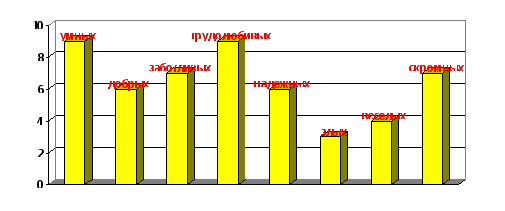
In the 6th grade, our self-portrait became like this:

We watched the guys in the 5th grade and in the 6th grade.






Creation of the "Calendar of birthdays of our classmates"
Every year we celebrate Birthday in the classroom - last year and in  that year:
that year:
 Grade 5 Grade 6
Grade 5 Grade 6
By the date of birth of each student, we have compiled a portrait "Calendar". They designated the following: "snowflake" - these are children born in winter, students " blooming cherry"- these are classmates who were born in the spring," sun "- the birthday of the summer," autumn leaves "- these are students whose birthdays are in the fall. After reviewing the responses to the questionnaire"The world of my hobbies",we have identified 4 groups of hobbies and interests. Based on the results of this questionnaire, we can conclude that we love to move, therefore, almost all children attend sport sections and mugs. And also our class loves to draw, dance, participate in competitions and sing. And it also turned out that we like to be on duty at school, to go to clean-ups to clean up the school grounds, to clean the office, to put things in order. Thus, we concluded that our class “Creative, athletic and hardworking. "



conclusions
All tasks set in research work are executed.
Thus, we have got a self-portrait of our class.
As a result of this research, we saw that the portrait of our class is very vivid. The main thing is that we, having different tempers, we learn to understand each other. Friendship helps us in this.

And what did this work give us?
All this knowledge will help us better understand the other person. We have acquired the ability to conduct a survey, process the results of the questionnaire, the ability to listen to the answers of classmates. We also acquired the skills to work in a text editor, in a graphic editor, skills in working with photographs and text at the same time.
With this work, we spoke to parents in the 5th grade at the holiday "Grade 5 Grade", this year we spoke at the school scientific and practical conference.


Literature
1. "Wikipedia. Encyclopedia ", version on-line.
2. S.I.Ozhegov, N.Yu.Shvedova "Explanatory Dictionary of the Russian Language", version on-line.
3.V. Dal Explanatory Dictionary of the Living Great Russian Language, version on-line.
4. Modern explanatory dictionary ed. "Great Soviet Encyclopedia", version on-line.
6. Photos of 5a and 6a grades. Archive of T.N. Malysheva
15

